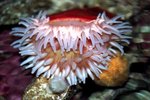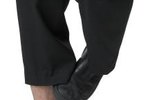
Leeches have a bad reputation. Their name is a term of opprobrium for someone who uses others for his own advantage, much as the real bloodsuckers live off the blood of the creatures' hosts. However, leeches aren't all bad. It's possible you could experience leech bites even if you never enter lakes or streams. In 2004, the United States Food and Drug Administration approved the use of certain leeches as medical devices.
Where Leeches Live
Globally, approximately 1,000 species of leech exist. North America is home to about 79 species. Leeches generally inhabit freshwater areas, but some live in estuaries and others live on land. In freshwater habitats, leeches prefer shallow areas with warmer temperatures and few waves. They hide in aquatic plants, rocks and junk found in waterways. Not all types of leeches suck blood. Some prey on insects, mollusks and fish.
The Little Suckers
Leeches attach to their prey via a suction cup at the end of their bodies. They use their heads to find a vulnerable area on the victim, such as an existing wound or thin-skinned location. They have a suction cups near their mouths. Leeches use these singular cups to attach to hosts and bite, leaving a mark shaped like a Y or V, depending on the species and the number of teeth. Hosts might not realize they've been bitten, since leeches inject an anesthetic to blunt a bite's pain and an anti-coagulant to prevent blood flow. They're then free to feed with their host none the wiser. Leeches can suck up to five times their weight in blood. They fall off on their own when they've consumed sufficient blood. A good meal can last them for months before they need to feed again.
If You're Bitten
If you emerge from the water with leeches clinging to you, your first instinct might be one of panic. Stay calm, because it's important to remove the leeches properly. Otherwise, leeches spit bacteria into the bite, which can cause infection. On the PBS website, leech expert Mark Siddall recommends allowing a leech to finish eating -- which takes about half an hour on a person. Since that isn't practical for most folks, find the smaller end of the leech, which is the head. Push it gently sideways so it will release suction. Then do the same with the leech's other end. It's normal for the bite to bleed after the leech falls off. Use antibacterial medication on the bite, not home remedies like salt. You should probably visit the doctor after your leech experience in case the parasite did pass on bacteria.
A Medical Renaissance
Since their heyday in the 19th century, leeches have made a comeback in the medical field. Today, they are used in microsurgery to aid in the reattachment of tiny veins or to prevent post-surgery vein engorgement, in areas ranging from limb reattachment to breast reconstruction. Medicinal leeches leave the Y-shaped mark on patients, which should disappear within a week or so after treatment.
References
Photo Credits
-
Michael Blann/Digital Vision/Getty Images
Writer Bio
Jane Meggitt has been a writer for more than 20 years. In addition to reporting for a major newspaper chain, she has been published in "Horse News," "Suburban Classic," "Hoof Beats," "Equine Journal" and other publications. She has a Bachelor of Arts in English from New York University and an Associate of Arts from the American Academy of Dramatics Arts, New York City.




